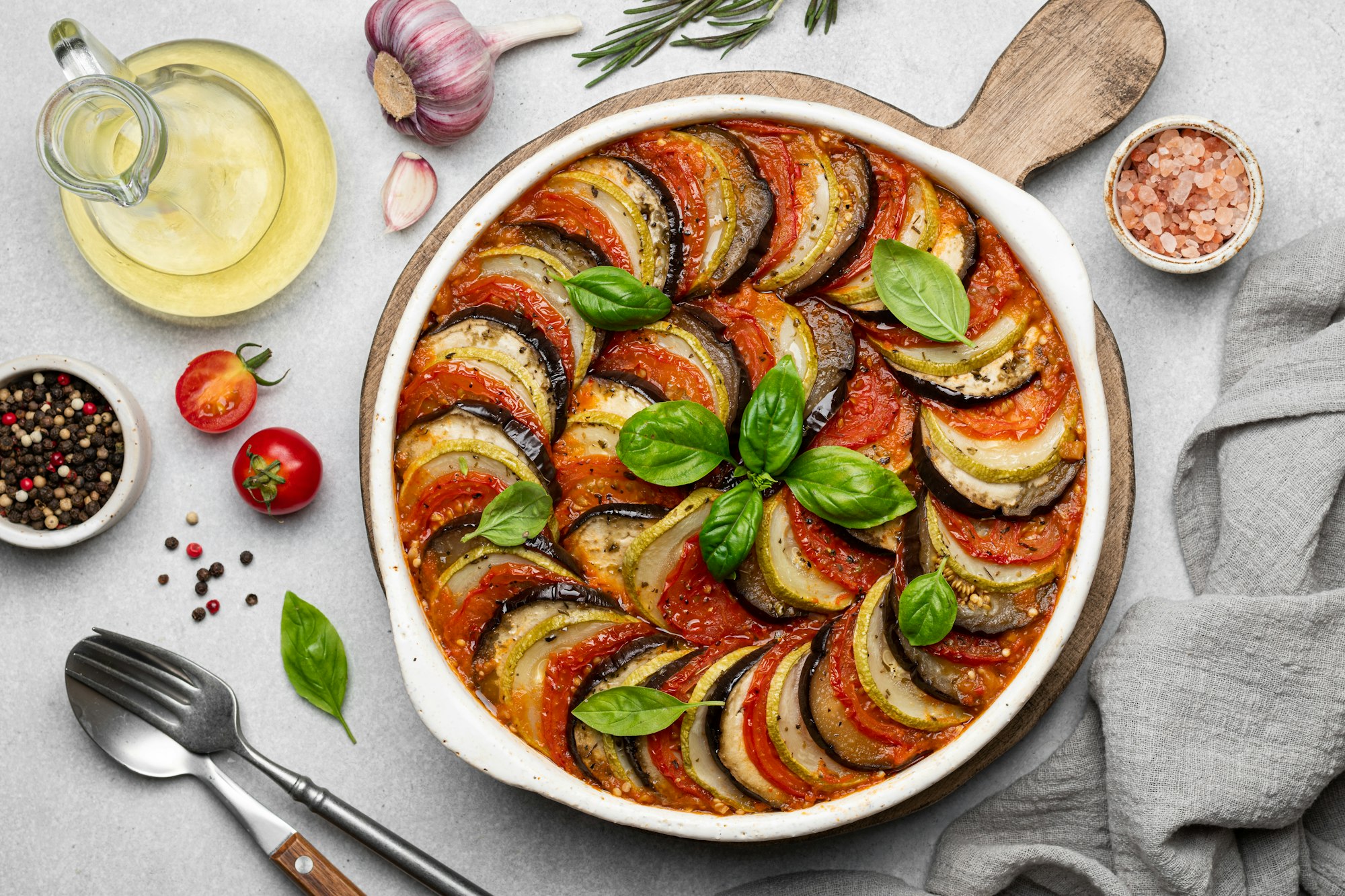How to Perfect the Classic French Ratatouille with a Modern Gastronomic Twist?

Ratatouille, a quintessential French dish, is a colourful mélange of summer vegetables simmered in olive oil. The vibrant mix of eggplant, zucchini, bell peppers, and tomatoes, seasoned with herbs and garlic, is known to evoke the sunny climes of Provence where it originated. This dish celebrates the bounty of the summer harvest and is an excellent example of how the French can transform a simple medley of vegetables into a gourmet feast. In this article, we’ll explore the traditional Ratatouille recipe and introduce a few modern twists to elevate this classic dish to new gastronomic heights.
Understanding the Key Ingredients
Every recipe starts with its ingredients, and in Ratatouille, each vegetable plays a crucial role in building the dish’s complex, layered flavours.
Sujet a lire : How Can You Craft a Savory Gourmet Quiche Lorraine with a Flaky Crust?
Eggplant is the heart of Ratatouille. Its sponge-like texture soaks up the olive oil, becoming tender and full of flavour. Zucchini adds a slightly sweet note and a different texture, while bell peppers bring a hint of smoky sweetness. Tomatoes contribute a tangy flavour and form the basis of the sauce, enhanced by garlic, salt, and freshly ground pepper.
The choice of Olive Oil is key to the dish’s flavour. Extra-virgin olive oil, with its fruity aroma and slight peppery kick, is perfect for Ratatouille. All these ingredients must be fresh, as the quality of the vegetables significantly affects the dish’s final taste.
Lire également : What’s the Best Technique for Making Authentic Gourmet Gazpacho Andaluz?
The Traditional Recipe
Once you’ve gathered the best quality ingredients, it’s time to delve into the traditional preparation method. A true Ratatouille recipe requires each vegetable to be cooked separately before they are all combined. This ensures that each vegetable retains its individual character, contributing to a medley of flavours and textures in the final dish.
Start by sautéing the diced eggplant and zucchini in hot olive oil in a large frying pan for about 10 minutes until they turn golden. Remove them from the pan and set them aside. In the same pan, add a little more olive oil and sauté the bell peppers until they are soft and slightly caramelised. Add the chopped garlic and sauté for a minute until fragrant. Finally, add the diced tomatoes and cook until they break down and form a thick sauce.
Once all the vegetables are cooked, combine them in the pan, season with salt and pepper, and simmer gently for about 20 minutes. During this time, the flavours meld together, and the vegetables become wonderfully tender.
Adding a Modern Twist
Now that you’ve mastered the traditional recipe, let’s explore ways to give this beloved French dish a modern gastronomic twist. One way is by incorporating additional or alternative ingredients. For instance, you could add a dash of balsamic vinegar for a subtle sweet-sour note. A hint of chilli can provide a spicy kick, while a sprinkle of za’atar or sumac can introduce an intriguing Middle Eastern twist.
Another way to modernise the Ratatouille is by playing with its presentation. Instead of serving it as a rustic stew, you can arrange the vegetables in a precise pattern in a baking dish, cover them with a tomato sauce, and bake until the vegetables are tender and the sauce is bubbling. This approach, made famous by the animated film ‘Ratatouille’, results in a dish that is visually stunning and bursting with flavour.
Elevating the Dish with Pairings and Plating
The final step to perfecting your Ratatouille is to consider how to plate and pair it. Ratatouille can be served as a main dish, a side, or even an appetiser. As a main, it pairs beautifully with a crusty French baguette or creamy polenta. As a side, it complements grilled meats or fish wonderfully.
For plating, consider serving your Ratatouille in individual ramekins or in a large, shallow serving dish to showcase the colourful vegetables. Garnish with fresh basil leaves or a dollop of goat cheese to add a fresh, tangy element that contrasts beautifully with the rich, sweet vegetables.
In the end, mastering Ratatouille is about understanding its essential ingredients, respecting the traditional cooking method, and having the courage to add your unique twist. With practice and a bit of creativity, you can transform this classic French dish into a gastronomic masterpiece that is a testament to the power of vegetables and the timeless appeal of French cuisine.
Mastering the Bake: Oven-Baked Ratatouille Tian
Having explored the traditional recipe and modern twists, let’s delve into another version: the Oven-Baked Ratatouille Tian. This technique involves arranging thinly sliced eggplant, zucchini, and bell pepper concentrically in a baking dish, reminiscent of the presentation in the film ‘Ratatouille’. This method not only makes for an aesthetically pleasing dish but also adds a new layer of texture to the medley of vegetables.
Start by thinly slicing the eggplant, zucchini, and bell peppers. In a separate bowl, prepare a simple tomato sauce by sautéing garlic in olive oil, adding diced tomatoes, and seasoning with salt and pepper. Once the tomatoes have broken down, stir in a handful of freshly chopped basil for an aromatic touch.
Pour a thin layer of the tomato sauce at the bottom of your baking dish. Arranged your sliced vegetables concentrically, alternating between eggplant, zucchini, and bell pepper. Drizzle the arrangement with olive oil, season with salt and pepper, and bake in a preheated oven for about 45 to 60 minutes, until the vegetables are tender and slightly caramelised.
This version of Ratatouille, known as a ‘Tian’, presents the dish in a new light. The slow baking process intensifies the flavours of the vegetables, while the precise arrangement introduces an element of refinement. The result is a baked Ratatouille that’s as pleasing to the eyes as it is to the palate.
Conclusion: The Endless Possibilities of Ratatouille
Ratatouille, with its vibrant colours and layered flavors, truly embodies the spirit of French cuisine. This humble dish of summer vegetables, simmered in olive oil and seasoned with herbs, is a testament to the power of simplicity in cooking. Yet, it also welcomes creativity and innovation, as seen in the modern twists and baked version we’ve explored.
Whether you’re a novice cook or a seasoned chef, Ratatouille offers endless possibilities. Stick to the traditional Ratatouille recipe for a comforting meal, or experiment with new ingredients and techniques for a modern twist. No matter how you choose to prepare it, always remember that the quality of your ingredients is key. Choose fresh, ripe vegetables and high-quality olive oil to truly bring out the flavours of this classic French dish.
In the end, Ratatouille is more than just a dish. It’s a celebration of the summer harvest, a culinary homage to Provence, and a testament to the timeless appeal of French cuisine. So, the next time you find yourself with a bounty of summer vegetables, why not whip up a pot of Ratatouille? You might just find yourself transported to the sunny climes of the French countryside, one bite at a time.
